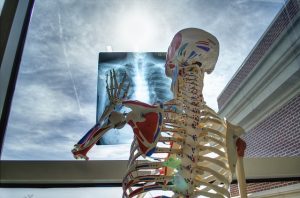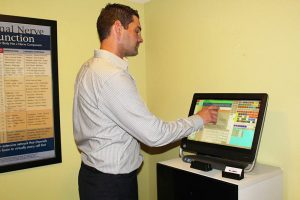The basic principle of chiropractic is that changes to the normal structure and function of the skeleton and its supporting structures such as the muscles can produce effects not just in those areas, but in other areas of the body and health in general. While the focus has been on the spine, chiropractors view all of the joints, surrounding muscles and nerves as potential sources of problems.
Traditionally, chiropractors have focused on the nervous system to explain these effects, but more recently the focus has included other mechanisms such as the effect of changes to the ‘kinematic chain’, where the function of one mechanical link in the body may have an effect on another link in the ‘chain’.
The nervous system and kinematic chain in chiropractic
According to chiropractors, the skeleton and muscles should not be viewed as separate from other parts of the body. The body is a whole, and all its parts interact. In chiropractic theory, the spine is particularly important, as nerves link the spine with all parts of the body, including the internal organs.
A misaligned or poorly moving area may produce local pain, but this may also have an effect elsewhere. For example, a problem with your lower spine may cause your upper spine to compensate and you may experience symptoms in the upper section such as a headache. This is an example of an effect on the kinematic chain. The chain can also produce effects down the body, where a lower back problem may cause you to walk incorrectly and perhaps develop ankle or knee pain.
Nerves that travel from the spine to another part of the body may be irritated at the spine, but produce symptoms elsewhere, such as pain in the leg or numbness in the toes (sciatica).
History of chiropractic treatment
Spinal manipulation has been used as a healing technique for thousands of years, but the modern version was developed in the late nineteenth century. Chiropractic is recognised as a genuine healthcare approach, and published research studies have found that it can be effective for people with a range of spinal and other problems.
Chiropractic treatment for disorders
Research supports the use of chiropractic for a range of disorders, including:
- Back injuries
- Headaches
- Lower back pain
- Migraines
- Period pain
- Problems with posture
- Sciatica (shooting pains in the leg)
- Problems with other joints such as the knees, shoulders, feet and hands.
The experience of some chiropractors and some studies also show that chiropractic management may help other conditions. However, more research is needed in this area.
What the chiropractor does
Your chiropractor will evaluate your health by asking about your condition and completing a thorough physical examination. This may involve watching how you stand and move, feeling your spine, head and pelvis, and requesting x-rays.
You may be adjusted while standing, sitting, lying down or in combination – it depends on your symptoms and the judgement of your chiropractor. You can sometimes hear a clicking or clunking sound as the spinal joints are adjusted, but this is usually painless.
There are a number of different methods of adjustments that use various degrees of hand pressure and specialised equipment, including:
- Using the hands to press or push
- Positioning the body to use gravity and the body’s own weight
- Using mechanical instruments
- Placing wedges under the body and using the body’s own weight
- Using specialised adjusting tables to assist the adjustments
- Using slow and sustained hand pressure or swifter movements.
Special considerations in chiropractic
If you have specific health conditions or other issues, the chiropractor will take them into account when deciding on your treatment. These assessments help the chiropractor to evaluate any special needs you may have and to ensure your safety and comfort during treatment.
These issues may include:
- Whether you have signs of or diagnosed arthritis
- Any suspected or recent fractures, bone breaks or trauma
- Disorders of the circulation
- Whether you are, or have recently been, pregnant
- Your body size
- Your age – whether you are young, elderly or frail
- The medication that you are taking
- Previous treatment, including operations.
Chiropractors are primary contact practitioners, which means they are trained to recognise when their treatment is appropriate and when a person needed to be referred to another healthcare practitioner.
Where to get help
- Australian Health Practitioner Regulation Agency Tel. 1300 419 495
- Chiropractors’ Association of Australia Tel. 1800 075 003
Things to remember
- Chiropractic can be an effective treatment for back pain, headache and injury.
- The chiropractor is trained to recognise when you will and will not benefit from their care.


 At Jones Family Chiropractic we offer in-house x-rays as a convenience to our patients so they don’t have to be referred out to another location.
At Jones Family Chiropractic we offer in-house x-rays as a convenience to our patients so they don’t have to be referred out to another location. Jones Family Chiropractic utilizes a state of the art software system that assists with all aspects of chiropractic care. Analysis, results, treatment schedules and progress are all kept in our system. Each time you visit us your private and secure patient history is available for you and Dr. Jones to review and discuss.
Jones Family Chiropractic utilizes a state of the art software system that assists with all aspects of chiropractic care. Analysis, results, treatment schedules and progress are all kept in our system. Each time you visit us your private and secure patient history is available for you and Dr. Jones to review and discuss. Complimentary 15 Minute Consultation*
Complimentary 15 Minute Consultation*